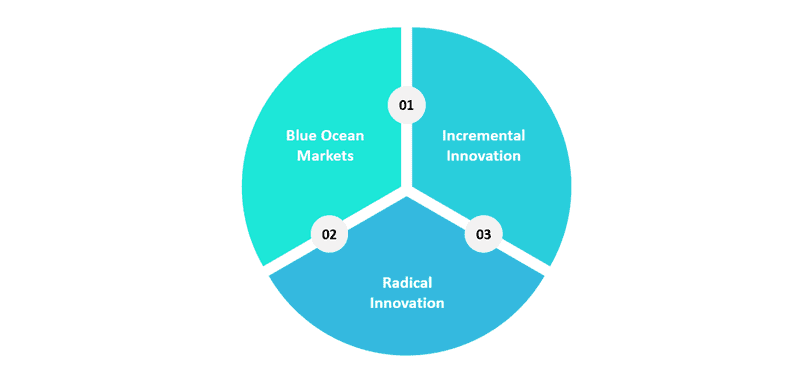Our content is reader supported, which means when you buy from links you click on, we may earn a commission.
Product Innovation Ideas in Digital Training and Online Courses

Most people hold the misconception that learning ends when one attains a degree or certification. In fact, it is a lifelong process of continual growth and improvement. There’s new knowledge being created and insight being discovered at every moment. The internet makes it so this knowledge is easily accessible and abundantly available.
As a result, we’re seeing rapid growth globally, no matter what field you’re working in, all thanks to our access to knowledge and information. But, in order to sustain the current level of performance, a continual workforce is required that exhibits the knowledge possessed by their predecessors.
Again, the internet is a reliable source for gaining such knowledge, harboring platforms that disperse information packaged in the form of online courses. They not only help us gain knowledge but supplement it when necessary. In turn, making a dynamic workforce that can adapt to the varying work requirements.
However, knowledge is by no means fixed. Just as the meat of what you’re learning is important, imparting it in a manner that is digestible and engaging for the audience is important as well. With so many eLearning platforms out there that follow the same format, what’s required is more product innovation in online courses.
Here we explore what product innovation is and how online courses can benefit from it.
What is Product Innovation?
In the simplest form, product innovation is adding value to some pre-existing design, process, methodology, and thinking such that it transforms into something new or exhibits radical improvement. Innovations may aim to:
- Cut down costs
- Offer a better solution to a problem
- Introduce efficiency to an otherwise inefficient process
- Stop bottlenecks
- Circumvent common issues
- For a competitive advantage
The above are just some examples, but all these objectives aim to strengthen one’s position. The value they add is revolutionary to the extent that it cannot be ignored. There are many ways to go about product innovation.
Here are 3 types of product innovation and how they can be used when it comes to digital training.

1. Incremental Innovation
As its name implies, incremental innovation refers to consecutive changes in a product or service made towards a larger transformative objective. This line of innovation entails a gradual change in a product or service so time for assimilation and retention is gauged from the market.
In terms of online courses, it means constantly updating a pre-existing course so it retains relevancy in the market. An online course full of generic information about a topic may benefit from this methodology as there is a lot of room to expand and broaden it.
Alternatively, it may be a market requirement. One can discover this by gauging feedback to an implemented change or by looking at the general market environment regarding the course topic.
For example, if you’re teaching an online course on data analytics and you find that there’s a growing demand for a certain tool, you can add that tool to the curriculum. The same goes for programming languages. There are a number of people looking into gaining programming skills; however, the demand for a certain one depends on the applications being done in the industry.
Advantages of Incremental Innovation
Incremental innovation brings with it certain advantages when employed. When you’re mapping out the future of your online course, it can benefit you in the following ways:
- Mitigated Risk: You want your online course to be successful and gain a wide audience. However, some upgrades or changes don’t end up receiving the expected outcome. Small incremental changes allow you to backtrack easily if a change isn’t received well.
- Fast results: Since the alterations you make are small, you can expect to get timely feedback on them.
- User Retention: It’s in our nature to resist something new, especially if we’re used to a particular platform. Small changes are easier to adapt to, allowing people to assimilate quickly. As a result, you won’t risk losing a pre-existing user base.
- Dynamic: Small changes in curricula are designed to impart more knowledge on the subject. It’s like a continuous addendum to a pre-existing information bank. Adding to it keeps it relevant and up to date.
- Potentially revolutionary: Something small has the potential to become something big. If you do enough incremental innovations, the chances are that one might turn out to be a radical approach.
2. Radical Innovation
Again as its name implies, radical innovation is a thought or an idea that is so iconic that it destroys previously held notions. As a result, it becomes the new norm, replacing the previously held belief about something. One of the most popular examples of radical innovation is Netflix and how its online streaming platform completely obliterated Blockbuster. It introduced convenience for the user, allowing them to rent movies and TV shows on a subscription basis online instead of going out of their way to a store and getting a physical copy.
In terms of online courses, radical innovation can mean introducing a new course that imparts knowledge on a pre-existing topic but uses a unique approach for imparting knowledge.
Or, it incorporates unprecedented tools that are far more user-friendly and easier to grasp. Using gamification in an online course is one example.
Advantages of Radical Innovation
Radical innovation too has some advantages:
- Bigger Reward: The more revolutionary the change to a product or service, the more time it’ll take for the market to catch up. Until then, you practically hold a monopoly over your respective field.
- Potential for a New Market: A radical innovation can aim to solve a problem that’s unheard of, in turn, creating a new market that seeks to solve the problem.
- Quick Adoption: If a problem lingers for too long, it gets hyped up and noticed by many players. As a result, the solution you bring to the table gets quickly adopted on account of the discussion surrounding it.
3. Blue Ocean Markets
Innovation doesn’t necessarily have to penetrate a pre-existing industry or field. You can have a thought or idea that is self-sustaining and broadens a view towards an entirely different market.
Blue ocean markets, first seen in the book Blue Ocean Strategy, are those without any barriers or competition. It points to the potential of innovation so that it makes an industry surrounding it.
An excellent example is the rise of social media. Before the advent of Facebook, nobody realized the potential for such platforms. It completely revolutionized the online industry, allowing a symbiotic relationship with other industries including, content, marketing, design, and web development.
Advantages of Blue Ocean Innovation
Uncontested: You’ll hardly find any competition; therefore, you can cash in while the market is hot.
- User Base: Being a pioneer has its advantages. You can establish a loyal user base that looks to you for solutions to their problems.
- Lower operational costs: Innovative ideas are hard to ignore if you’re the only person doing them. Therefore, you won’t have to spend much on marketing when getting your idea out there.
- Flexible: Since you incepted the idea, you are in charge of charting a direction for it. Having no competition leaves you with a lot of room to experiment.
- No time constraints: Companies in the same businesses compete for a larger market share. If you control the market, you have all the time in the world to add further value to your idea or service.
Challenges of Product Innovation
Unfortunately, product innovation isn’t an easy task. If it were, we’d be seeing new ideas springing into action every day.
Sometimes, those who have a revolutionary idea don’t have the means, confidence, or vision to implement it.
That’s why there are many challenges that need to be overcome before any tangible steps can be taken towards achieving an innovative goal. These steps include:
- Creativity: Figuring out an innovative solution to a problem may stem from logical roots. That is, you might encounter a straightforward answer to a question; however, adding creativity to it is the difficult part.
- Working Prototype: You might have a vision in mind as to what your product or service should look like, but creating a prototype is hard work and requires that you devote the necessary time and energy to it.
- Investment: The bigger the idea, the more investment it’ll require. In addition, you may have certain standards to keep in mind before cementing your idea down. Sometimes these solutions may require convincing investors. And generally, revolutionary ideas attract less attention from investors, given the risk involved in penetrating a pre-existing market.
- Market Penetration: Once your product or service reaches fruition, you may need to convince consumers to adopt it. If an idea is radical or unheard of, the chances are that it may gain traction on its own. But, if you’re going against big names in the industry, you may need to invest further in marketing.
- Time Constraints: One of the biggest disadvantages of innovation is that there’s certain timing to it. Market competitors may get wind of your idea and produce it quicker, considering the vast resources at their disposal and pre-existing foundation of knowledge. Alternatively, the world may not yet be ready for your idea, or technology hasn’t caught up to make it reach its full potential.
How to go about Product Innovation?
There’s no surefire way to innovation. It greatly depends on your circumstances, how much support you receive, and what you’re willing to sacrifice.

It’s more about the way you think that‘ll help you outline your vision. Some people are fortunate enough to have this innate skill; others learn it with time, in the process of constant failure, until something sticks out. Here are a few helpful ideas:
-
Start Small
To bring product innovation to light, always remember to start small. If you go big initially, you risk losing out from the get-go. This translates to a degree of loss that you may not be in a position to afford. Additionally, this initial jerk may prevent you from going ahead with your ideas in the future.
Therefore, always chart out a plan of action before going ahead with an endeavor. Identify the potential bottlenecks and try to work on ways of getting around them.
-
Connect the Dots
Finding patterns within a sea of information is perhaps one of the most difficult tasks a human can do. However, it is a skill that grows with time. Look for out-of-the-box solutions by connecting multiple ideas. Employ the means of technology to get better results that yield solutions quicker.
-
Don’t be a Perfectionist
There’s no limit to how good something can be as you’ll find many ways to improve upon it. Remember that you’re on a time constraint. Being nitpicky about a small aspect of the bigger picture may become a hindrance to your goals. The important thing to realize is when to stop.
If you keep on delaying your intended output, you may get to where you never launch in the first place. This doesn’t help anyone.
-
Expand Industry knowledge
Sometimes you may stumble upon an obvious innovation to a pre-existing industry; however, you may be looking at it from an external lens, without prior knowledge or experience. In that case, you’ll need to do some research on that industry before going ahead with your product innovation.
You may feel that your idea is perfect for the industry, but it may fail to consider its inner workings. To prevent any roadblocks down the line, see if your idea is even feasible in the first place.
Ways to Achieve Innovation in the eLearning Industry
Coming back to the eLearning industry, the general guidelines are the same for introducing product innovation. After you’ve identified what kind of approach you need to follow, you can consider some of the following steps to make your online courses stand out from the competition.
-
Different Formats
Lots of courses try to keep a tried and tested format for their eLearning courses; however, you’ll find that there are a number of different ways you can go about teaching yours.
Most of them rely on a cognitive approach – the classic teacher and student relationship. But you can incorporate a behavioral or experiential approach, too. With each, you can draft a different format that facilitates your eLearning course.
-
Gamification
We’re all aware that learning a new skill or consuming lots of information can become tiresome. What you need is a way to keep audiences engaged while they’re going through your literature. Introducing eLearning games is an excellent way to keep users attentive while helping them retain knowledge. It incentivizes learning outcomes, allowing engagement with what’s being taught.
Plus, it makes the learning process more fun and adds the element of healthy competition. Users will try to get ahead of the competition to earn points, letting them gauge their standing and something they can boast about online.
-
Specialization
Some topics are not as vast in their scope. As a result, they can be neatly compressed into an online course that delivers all the necessary knowledge for one to become a specialist in them. This way, users can focus on what they require instead of going about a course that will take significant time and energy to complete.
Specialization can also help users cover aspects of a much broader topic. It makes it easier to design a course that’s much easier for the user to comprehend when it is segmented. Essentially, breaking them down into levels that one can achieve in their own time.
-
Bundling
Users are always on the lookout for deals wherever they go. Having an effective bundling strategy can help you identify correlations between online courses. When bundled together, you can save on marketing costs, and your users can explore the options available to them.
-
Support
Offering support is another way to introduce product innovation in eLearning courses. It can be in the form of technical support, aiding users when they face any problems on the online platform.
Or, it can be in the form of a tutor, connecting specialists to people who require assistance in learning. This also makes the course more inclusive as people with special needs might require some assistance.
-
Connections
Some people learn a new skill or gain knowledge just for the heck of it, but for some, motivation comes in the form of better job prospects. Letting these users have access to an online portal that connects them to like-minded people can help them achieve their goals. In addition, it helps companies get in touch with the workforce more easily.
FAQs on Product Innovation
What is product design?
Product design is the process of creating new products. It includes the conception, development, and production of new product ideas. Product design also encompasses the study of user needs and how to meet them.
The goal of product design is to create products that are functional and appealing. A successful product must meet the needs of its target market. It should also be easy to use and be manufactured at a reasonable cost.
What is user experience (UX)?
UX, or user experience, refers to a user’s thoughts while using a software program, device, or web page.
UX also encompasses a user’s emotional state. This might include their level of frustration, anxiety, or confusion.
Good UX can make using a product feel effortless and intuitive. Bad UX can make even the simplest task feel confusing and frustrating.
What are some trends in elearning and instructional design?
One trend is the move towards more mobile learning experiences. Learners are expected to access content on their mobile devices.
Another popular trend is the use of gamification in elearning. Gamification elements such as points, badges, and leaderboards are popular. They help to motivate learners and engage with content in a fun and challenging way.
Finally, there’s a shift towards more informal, social learning experiences. That’s where many learners are now turning to their peers for support and guidance.
How is instructional design evolving?
Instructional design is an ever-changing field. Instructional designers must keep up with the changing technology when it comes to online learning.
This includes finding ways to make better mobile learning experiences. Adding in gamification is another way to improve learning online.
Conclusion
The above are just a few ways to introduce an innovative eLearning platform. However, you’ll find that many online course providers are already including them as part of their curriculum. The key takeaway is to do it differently and in such a way that it is unique and adds value to your teaching methodology.
Product innovation is by no means easy to implement, however with the right attitude, being open to new ideas and approaches, and by doing extensive research, your eLearning platform can come out on top.